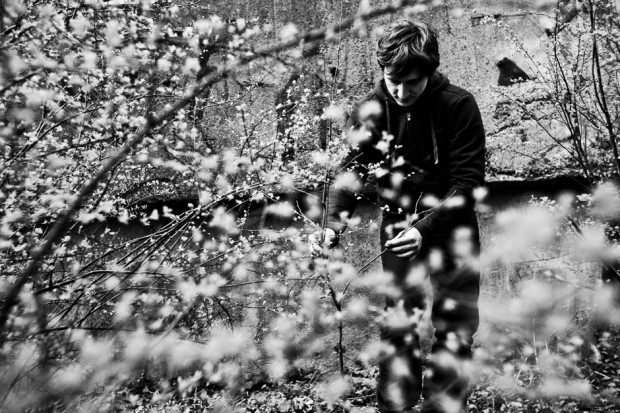
Artist Łukasz Surowiec, Photo: Marcin Kaliński
Speech by Hilla Metzner on occasion of the planting of two birch trees at the Ruth-Cohn-School
Hilla Menzer is a teacher at a school for social education in Berlin. Her aim is to make young people aware of the destructive but also brave forces that drive or had driven the mankind, politics, war and the Holocaust.
As I was preparing myself for today, I was thinking what does a birch tree mean to me.
My first birch stood in front of our house in Hilden, Rheinland, where I lived during my childhood and youth. I felt its smooth skin with cracks and liked to pluck strings from its white bark. I was happy to see the light spots on our lawn, which appeared whenever the sun shone trough its leaves; they seemed so alive. In the beginning, the tree was almost shaky, the branches were soft and moved whenever the wind blew.
Now another story. After the political shift in 1989, I started to be more and more interested in our neighbors, the Poles. I wanted to explore the light, the distances in the east, which I knew only from films, short stories and novels. I was also interested in the Polish culture and the people. They managed to protect something of their own from the communism and they developed it further. They also had suffered greatly under the Germans, especially under my father's generation. Still, many of whom I met, received me, with my my bumpy Polish, very friendly.
In 1984, when I visited Auschwitz with my school class for the first time, I was so shocked by the grounds, by the horror that I could only see the tracks, the chambers, the barracks, but no birch trees or the beauty of Krakow.
I started to learn Polish after 1995, I often traveled to Poland and started to realize that birch trees are part of the Polish cultural landscape–in the east, south and north of Poland–and also in Birkenau. The biggest birch trees I saw were in Lancut, a castle near Rzeszow in southern Poland. They were more than 40 meters high and offered a wonderful roof under which you could lie in the grass.
Three weeks ago, on the way back from Krakow, where I was after Easter, I saw the fresh green birch trees along the edge of the train tracks and many rows of trees and tree islands in the landscape; I am delighted every time I see these beautiful trees. But now, they are not only beautiful trees to me, they are also connected with the German and Polish history of National Socialism.
So I felt personally addressed, when I got the invitation to this birch plantation with Lukasz Surowiec at the gardening school Ilse Demme in Wilmersdorf few weeks ago. Ilse Demme was a teacher and social worker in Wilmersdorf, during the war she was as a Jew in Auschwitz, one of the few to survive.
After 1949, she founded this gardening school for children and young people, which now has six new birches from Birkenau. In our school there are references to a birch tree planting from Auschwitz / Birkenau. Every year we celebrate with those who witnessed and suffered, the day of the liberation of Auschwitz on January 27.
The fact that the Germans moored extermination camps such as Majdanek, Treblinka, Brzezinka during the war in Poland, which are still places of remembrance today, made many people interested in this particular part of the polish history. So is Auschwitz to many Germans only a symbol of a death camp today, Birkenau, Brzezinka, it is not perceived as a meadow.
“Poland is not only a Jewish graveyard”–it was written in the newspaper of the 7th Biennale for Contemporary Art, in the framework of which this action takes place today.
This retrospective view is not always easy–especially for the young Poles, for they were and are often perceived not as independent people in Poland’s current diverse culture, but in conjunction with places of extermination, which are only a small part of their history, but a large part of our history.
So if we take with this planting today a small place full of memories from Poland to Berlin, then it can be both–a reminder of all the political and social crime and human misery associated with Auschwitz and Birkenau, but also an occasion to open the view even further for our eastern neighbors in Poland.
Trees are always forward-looking and living organisms, which show us how deeply we are connected with the nature. For me this is another important symbol. It is my desire to establish a partnership with a Polish school.
In this way, I would like to thank Lukasz Surowiec who had this idea and realized it.






On Twitter
No Responses / Leave a Reply